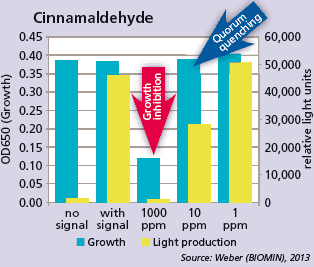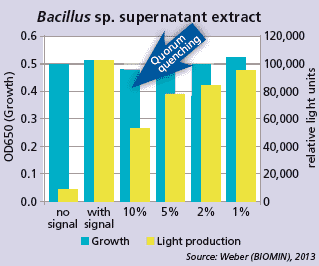How does bacterial chatter work?
Quorum sensing is mainly mediated by small, diffusible signal molecules. Cells produce these molecules continuously and as the population grows, these molecules accumulate. When molecules reach a certain threshold, concentration changes in gene expression are triggered and lead to changes in population behaviour.
Signal molecules can be viewed as languages. Many species have their own specific language, but they can also communicate with other species. For Gram-negative bacteria the language is generally based on acylated homoserine lactones (AHLs), whereas for Gram-positive bacteria the language is based on small peptides. Variations and modifications of these structures confer species-specificity. Both types of bacteria produce and respond to a molecule called AI-2. AI-2 represents a universal language comparable to English that allows the transfer of information within a multispecies community. Different groups of bacteria, e.g. Vibrios have their own language that is not specific for a distinct strain, but a group of related species.
Why do bacteria need to communicate?
Communication helps bacteria to organise themselves and to decide whether it is worthwhile to invest energy in the expression of virulence genes, biofilm formation, light emission, DNA uptake, production of antimicrobials and exoenzymes and many other traits. Many of these processes, such as virulence, are costly and might only be successful, for instance if the population is large enough to buffer losses due to the hosts´ defense system. Quorum sensing also provides information about the metabolic state of a community, species composition, and competitors for nutrients in a certain niche.
Quorum sensing is important for virulence, especially for pathogens that are relevant for aquaculture, such as Aeromonas, Vibrio, or Yersinia. Vibrio harveyi, the causative agent of luminescent Vibriosis in shrimp, is known to use quorum sensing mechanisms to regulate its virulence.
Can communication be disturbed?
The inhibition of communication is called quorum quenching. Several quorum sensing inhibitors that interfere with communication lines have already evolved in nature. Algae, sponges, plants and many bacteria produce different kinds of inhibitors that either destroy signal molecules, block signal molecule production or sabotage signal molecule detection.
Test systems
To test quorum quenching, several biosensor strains are available. In the presence of signal molecules, these strains induce light production, purple pigmentation, fluorescence, or other easily detectable traits. If at the same time an inhibitory substance or enzymes that destroy the
molecules are present, these traits are quenched (Table 1).
Quorum quenching—practical examples
Algae and plants (e.g., red macroalgae, cinnamon, garlic, ginger) produce compounds that mimic AHLs or destabilise the detectors and thereby block the information flow. A famous quorum quenching phytogenic substance is cinnamaldehyde (Figure 1). We have performed several tests in our laboratories and could confirm its quorum quenching activity.
Many Gram-positive bacteria, including probiotic strains such as Bacillus sp. produce enzymes such as AHL-lactonase or AHL-acylase that deactivate the communication of Gram-negative bacteria by degrading the AHL signal molecule. Analysis of the probiotic Bacillus present in AquaStar® revealed
that this strain is able to interfere with bacterial communication (Figure 2). Thus, quorum quenching is part of the mode of action of AquaStar® probiotics.
Information is critical
Disrupting communication lines will interfere with information transfer and lead to uncoordinated behaviour. In the case of pathogens, this interference could prevent the outbreak of infectious diseases, because the pathogens cannot arm themselves properly and are thus more vulnerable and easier to kill. In the light of increasing microbial resistances to antibiotics, targeting a mechanism not related to growth provides a means for controlling pathogens.
July 2014





